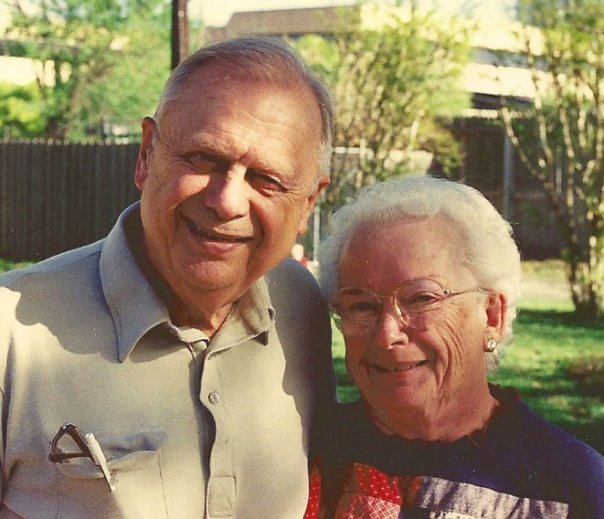 My mother, Margaret Allen Kirkendall, died yesterday evening at Finley Hospital in Dubuque, Iowa after a lengthy illness. She was 86 years old.
My mother, Margaret Allen Kirkendall, died yesterday evening at Finley Hospital in Dubuque, Iowa after a lengthy illness. She was 86 years old.
The following is a lovely obituary for Margaret that my brother Matt wrote with contributions from many of my siblings. It conveys well the special nature of this remarkable woman and her considerable contribution to making Houston a better place to live.
Margaret Allen Kirkendall died on Thursday, May 28, 2009 at 9:22 P.M at Finley Hospital in Dubuque, Iowa after a lengthy illness. She was 86 years old. Funeral arrangements are pending with Egelhof, Siegert, & Casper Funeral Homes in Dubuque, Iowa making the arrangements. The Funeral Mass and burial will be in Texas.
Margaret Jane Allen was born on March 24, 1923 in Cedar Rapids, Iowa, the first child of Grace (Payne) and William Allen. She grew up in Cedar Rapids and graduated from Franklin High School in 1940. At an early age, Margaret decided to become a nurse and eventually put herself through the nursing program at the University of Iowa in nearby Iowa City, graduating with an RN degree in 1946.
Margaret planned to pursue a career in academic nursing, but met a new medical resident, Dr. Walter M. Kirkendall, who had come to the University of Iowa following his military service in Italy during World War II. In their own version of “Pride and Prejudice,” initial mutual irritation turned into fascination, and subsequently, love. They were married at St. Thomas More Catholic Church in Iowa City on March 30, 1948 with Father McElhaney officiating.
Throughout their life together, Walter and Margaret had a close relationship and truly seemed to complete one another. As Walter pursued his academic career in medicine at the University of Iowa Medical School, Margaret supported his efforts and always worked to provide a stable home life for him, providing the venerable “safe port in stormy weather”.
Margaret and Walter were the proud parents of 10 children. During the 1960’s, their home at 430 Brown Street in Iowa City was known as a busy and often boisterous place. There was always an open door for the frequent visitors and Margaret was well known for her energy, hospitality, and plentiful food (industrial cooking she termed it). To the amazement and consternation of her children, she developed a system of friends and community contacts through which she seemed to know the names and activities of every child in the Iowa City/Coralville area. The result of this was that her children found that they could never get anything by her (not that they didn’t try on occasion).
In 1971, Walter accepted an opportunity to help establish a new medical school at the Texas Medical Center and moved the family to Houston. Margaret admitted to some trepidation at leaving Iowa and her many friends, but she lived by her often-quoted adage that “you bloom where you are planted.” With this attitude, it was not long before she brought many new friends and Texas traditions into her life that was centered around the vibrant home she established for her family at the corner of Sage Road and Del Monte Drive in Houston. Margaret transferred her open door policy from Iowa to her family’s new home in Houston and, over the ensuing 20 years, literally hundreds of medical students, colleagues, and other friends were attracted to the dynamic household that Margaret lovingly maintained.
Throughout this time, Walter and Margaret continued to work as a team to help establish the Department of Internal Medicine at the University of Texas Medical School at Houston. Their efforts helped set the foundation for the medical school and its subsequent development into a premier teaching institution.
At Walter’s death in 1991, Margaret admitted that a large part of her died with him. Despite her loss, she remained busy with her family and friends and participated in a wide variety of community service, often as what she termed as “the old nurse.” In retirement, she lived in New Braunfels and then Austin, Texas until she finally returned to Iowa, to live in Dubuque.
While her later years were hampered by illness and disability, she has been supported throughout this time by her many friends, especially Nora Lee Balmer, Jean Eckstein, and Virginia Grady of Iowa City, Dr. Jack Tausend of Houston, Texas, and her oldest and dearest friend, “Auntie Ruth” Pichette, of Highland, Michigan.
She is survived by her sister, Francis Allen Rassenfoss of Park Ridge, Illinois and her 10 children: W.C. (Alice) of Seguin, Texas; James (Kathleen) of Minneapolis, Minnesota; Matthew (Isabelle) of Dubuque, Iowa; Thomas (Susan) of the Woodlands, Texas; David (Ann) of Tomball, Texas; Nancy (Robert) Cook of Austin, Texas; Mary of San Antonio, Texas; Kathryn (Gene) Acuna of Austin, Texas; Joseph of Los Angeles, California; Michael of Austin, Texas; her 32 grandchildren and five great grandchildren, (with another on the way).
Memorial gifts may be sent to the endowment for the Walter M. Kirkendall, M.D. Lecture Series in Internal Medicine at the University of Texas Medical School, 6431 Fannin, MSB. 1.122, Houston, TX, 77030, in care of Philip C. Johnson, M.D, F.A.C.P.
The family would like to acknowledge and thank the following: Father Dwayne Thoman, Deacon Dave McGhee, and Sister Damian O’Brien for their strong spiritual support; Dr. Ronald Iverson, Dr. Darryl Mozena, Dr. Roger Shafer, the administration, nurses, and staff of Stonehill Nursing Home, and the nurses and staff of the 5th floor at the Finley Hospital for their expert and compassionate care of Margaret. Finally, the family extends our most heartfelt thanks to Joan Reimer, who provided Margaret with selfless, dedicated, and loving attention as her caregiver over the final years of her life.
Funeral arrangements are being handled by Tres Hewell Mortuary,165 Tor Dr. Seguin, TX (830) 549-5912 (www.treshewell.com). The family will greet friends at the funeral home on Tuesday, June 2nd from 5-7 p.m., and a Rosary will follow at 7 p.m.
The funeral will be on Wednesday, June 3rd at 10 a.m. at St. Peter and Paul Catholic Church, 386 N. Castell St, New Braunfels, TX. The family will have a reception for friends at the church immediately following the funeral.
Like this:
Like Loading...
 The best local restaurant evaluation guide — Fearless Critic Houston Restaurant Guide 2010 — is now available. The brutally honest restaurant guide is put together by a group of undercover local critics who "dine incognito, don’t accept freebies, and don’t pull punches" in rating a cross-section of 450 restaurants in the Houston metropolitan area.
The best local restaurant evaluation guide — Fearless Critic Houston Restaurant Guide 2010 — is now available. The brutally honest restaurant guide is put together by a group of undercover local critics who "dine incognito, don’t accept freebies, and don’t pull punches" in rating a cross-section of 450 restaurants in the Houston metropolitan area.









 My mother, Margaret Allen Kirkendall, died yesterday evening at Finley Hospital in Dubuque, Iowa after a lengthy illness. She was 86 years old.
My mother, Margaret Allen Kirkendall, died yesterday evening at Finley Hospital in Dubuque, Iowa after a lengthy illness. She was 86 years old.